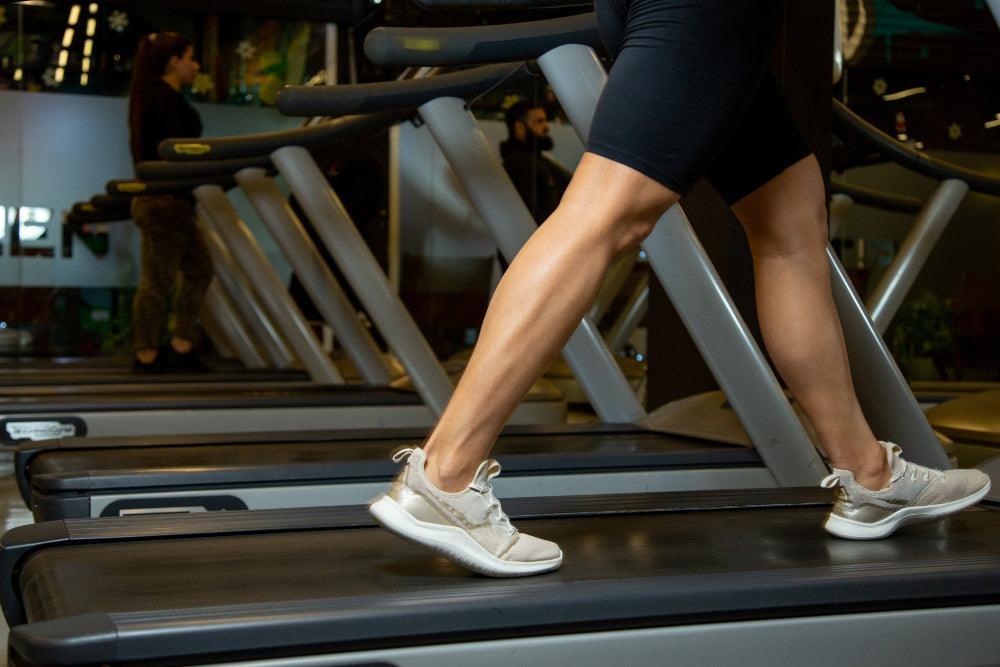Why is It Important Train Legs (Don’t Skip Leg Day)


Related products
What does 'Leg Day' Mean?
The concept of 'Leg Day' has become a colloquial term within the fitness community, referring to a workout session focused primarily on the lower body muscles such as the quadriceps, hamstrings, glutes, and calves. Despite its recognized importance, many gym-goers often exhibit a tendency to forgo this critical component of their exercise regimen. The reasons for skipping leg day vary, with explanations ranging from the perceived lack of aesthetic appeal of leg muscles to the sheer intensity and discomfort associated with a rigorous lower-body workout.
Dr. Alexandra Strong, a physiotherapist with a decade of experience in sports injuries, emphasises the detrimental effects of such an imbalance: "Neglecting the lower body can lead to muscular imbalances which not only affect your performance but also increase the risk of injuries." Statistically, a survey by the National Fitness Foundation found that approximately 40% of regular gym attendees admit to skipping leg day at least once in two weeks.
The overarching benefits of training legs encompass not only enhanced muscular symmetry and balance but also improvements in overall strength, stamina, and metabolic rate. Engaging in compound movements like squats and deadlifts during leg workouts can stimulate hormone release, namely testosterone and growth hormone, which are pivotal for muscle growth and overall health.
It is vital to integrate leg day into your fitness routine to foster a holistic approach to physical well-being. The key theme of the article, which will be referenced throughout, is the holistic integration of leg workouts for optimal physical fitness and the consequences of neglecting this fundamental aspect.
The Science Behind Leg Workouts

Understanding Muscle Hypertrophy
Leg workouts are not just about enhancing muscular appearance; they involve complex physiological processes like muscle hypertrophy, which is the enlargement of muscle fibres through strength training. Dr. Henry Wright, a leading sports medicine expert, explains: "When you perform resistance training, you create microscopic tears in the muscle fibres. During recovery, these fibres repair and grow thicker, leading to muscle hypertrophy."
The Role of Hormones
Hormonal responses also play a crucial role in this process. Endocrinologist Dr. Laura Simmons notes, "Exercises targeting larger muscle groups, such as the legs, can increase the production of anabolic hormones, which are crucial for muscle repair and growth." This hormonal surge not only benefits the legs but contributes to upper body muscle development as well.
Metabolic Impact
Furthermore, leg workouts have a significant impact on one's metabolism. The lower body contains some of the largest muscles in the body, and engaging them requires substantial energy. As a result, calories continue to be burnt long after the workout has concluded. This phenomenon, known as Excess Post-exercise Oxygen Consumption (EPOC), is integral to weight management and overall health.
The Psychological Aspect of Leg Workouts
Overcoming Discomfort
One of the psychological barriers to leg day is the anticipation of discomfort. Leg workouts can be demanding, and this sometimes leads to avoidance behaviour. Sports psychologist Dr. Fiona Gilbert states, "The discomfort experienced during leg workouts is often more intense due to the larger muscle groups involved. However, overcoming this mental barrier can lead to increased resilience and a more robust mindset towards training."
Reward Mechanisms
The reward mechanisms in the brain also play a part in reinforcing consistent leg training. The release of endorphins post-workout provides a 'natural high', contributing to the 'feel-good' factor which can motivate individuals to maintain a comprehensive workout routine that includes leg day.
The Impact on Athletic Performance
Enhancing Core Stability
Leg strength is fundamental to athletic performance, providing the foundation for speed, agility, and endurance. Dr. Strong reiterates, "Core stability is rooted in the strength of the lower body. Strong legs provide the platform for virtually every movement in sport."
Injury Prevention
Moreover, a well-conditioned lower body can act as a bulwark against injuries. Orthopaedic surgeon Dr. Ian Murphy states, "A common cause of sports injuries is the lack of proper support from the lower body muscles. Strengthening these muscles can significantly reduce the risk of injuries, particularly in the knees and lower back."
Long-Term Health Benefits
Training legs not only enhances immediate athletic performance but also has long-term health benefits. As people age, leg strength becomes a critical factor in maintaining mobility and independence. Regular leg workouts can mitigate the risks associated with age-related muscle atrophy and bone density loss.
The avoidance of leg day is a multifaceted issue, with roots in both physical and psychological challenges. Yet, the benefits of persevering with a comprehensive leg workout are unequivocal, influencing everything from metabolic rate to long-term mobility. As Dr. Simmons succinctly puts it, "Leg day is not merely a workout routine; it's an investment in your long-term health and fitness." This article has explored the many layers of leg day, highlighting its essential role in a balanced and effective fitness regimen, and underscoring the theme of holistic physical well-being
The Anatomy of the Lower Body
The lower body is an intricate system composed of various muscle groups, each playing a pivotal role in our daily movements. Understanding the anatomy of these muscles is essential for appreciating their function in our overall mobility and stability.
Major Muscle Groups in the Lower Body
The major muscle groups of the lower body include the quadriceps, hamstrings, glutes, hip flexors, adductors, abductors, and calf muscles. Each group is responsible for specific movements and contributes to our balance and posture.
Quadriceps
The quadriceps, or 'quads', are a group of four muscles at the front of the thigh. They are primarily responsible for extending the knee and play a significant role in walking, running, and jumping. Dr. Fiona Hayes, an exercise physiologist, states, "The quads are not just pivotal for locomotion but also for knee joint stability, which is crucial for both everyday activities and athletic performance."
Hamstrings
Opposite the quads, we find the hamstrings, consisting of three muscles at the back of the thigh. "They work in concert with the quadriceps to facilitate controlled movements and are essential for deceleration, which is vital to prevent injuries," explains Dr. Martin Lloyd, a specialist in sports medicine.
Glutes
The gluteal muscles, commonly known as the glutes, include three muscles that make up the buttocks. "The glutes are the powerhouse of the human body, providing the thrust needed for propulsion and the strength for lifting," says Dr. Angela Robbins, a renowned orthopaedic surgeon. They are key for movements such as rising from a sitting position, climbing stairs, and maintaining upright posture.
Hip Flexors
The hip flexors are a group of muscles near the front of the hip. They are instrumental in lifting the knees and bending at the waist. "Tight or weak hip flexors can lead to a range of mobility issues, including lower back pain," warns Dr. Hayes.
Adductors and Abductors
The adductors and abductors control the movement of the thigh towards and away from the body's midline, respectively. Dr. Lloyd elaborates, "These muscle groups work in harmony to enable lateral movements and contribute to the stability of the pelvis during dynamic activities."
Calf Muscles

Finally, the calf muscles, consisting of the gastrocnemius and soleus, play a role in pushing the foot off the ground when walking, running, or jumping. "The calf muscles are often underappreciated, yet they are essential for ankle stability and the proper distribution of body weight through the foot," Dr. Robbins adds.
The Role of Each Muscle Group in Overall Mobility and Stability
Each of these muscle groups plays a critical role in our overall mobility and stability. The lower body muscles work synergistically to allow complex movements while maintaining balance and posture. The muscle groups of the lower body are akin to the components of a well-oiled machine, with each part essential to the function of the whole.
Mobility
In terms of mobility, the lower body muscles are involved in every step we take. "Whether you're walking, running, or simply standing, your lower body muscles are constantly at work," Dr. Hayes remarks. They allow us to move in multiple planes of motion, adapting to different terrains and activities.
Stability
As for stability, the muscles of the lower body are fundamental in maintaining our centre of gravity. Dr. Lloyd explains, "Stability is not just about standing still; it's about controlling movement. Strong lower body muscles mean better control and less risk of falls or missteps."
Holistic Functionality
Furthermore, the functionality of the lower body is not isolated; it impacts the holistic well-being of the individual. "Every action from the lower body sends repercussions through the upper body, affecting spinal alignment, abdominal strength, and even shoulder positioning," Dr. Robbins highlights.
Physiological Benefits of Leg Training

Training the lower body is not merely a segment of a balanced workout routine; it is a fundamental aspect of overall physiological health. The benefits of leg training extend far beyond the muscles themselves, influencing everything from metabolic function to hormonal balance.
Increased Muscle Mass and Metabolism
How Leg Training Contributes to Lean Muscle Growth
Leg training is highly effective in developing lean muscle mass. "The activation of large muscle groups in the lower body through exercises like squats and lunges leads to significant muscle growth," according to Dr. Samantha Pearce, a kinesiologist. This growth is attributed to the hypertrophic adaptation of muscles being repetitively challenged with resistance, causing an increase in muscle fibre size.
Impact on Resting Metabolic Rate
The development of muscle mass in the legs has a direct correlation with one's resting metabolic rate (RMR). Dr. Pearce further elaborates, "More muscle mass equates to a higher metabolic rate. Essentially, your body burns more calories at rest when you have more muscle." This is particularly significant given the size of the lower body muscles, which means they can consume a considerable amount of energy even when not actively exercising.
Hormonal Benefits
Testosterone and Growth Hormone Response to Leg Workouts
Leg workouts can induce a robust hormonal response, particularly in the secretion of testosterone and growth hormones, which are critical for muscle repair and growth. Endocrinologist Dr. Neil Thomas explains, "Compound movements that recruit the lower body are known to enhance the body's anabolic environment, thereby supporting muscle synthesis and recovery."
Effects on Overall Body Composition
The hormonal surge from leg training not only benefits the targeted muscles but has systemic effects. "By stimulating these hormones, you're not just improving leg strength, you're potentially enhancing your overall body composition," says Dr. Thomas. This means an increase in muscle mass and a decrease in fat throughout the body, leading to a leaner and more toned physique.
Improved Functional Strength
Real-life Applications of Lower Body Strength
The strength gained from regular leg workouts translates into improved performance in daily activities. "From climbing stairs to lifting heavy objects, the functional benefits of leg strength are numerous," states physiotherapist Dr. Oliver Grant. This functional strength is crucial for maintaining independence, particularly as one ages.
How Leg Strength Supports Upper Body Workouts
Moreover, a strong lower body provides a stable base for upper body workouts. Dr. Grant adds, "You can't fire a cannon from a canoe. Similarly, you need a strong and stable base to effectively train the upper body." Leg strength allows for more power and stability during upper body exercises, leading to better overall workout performance.
Why Is It Important to Train Your Legs?
Training the legs is imperative for achieving a harmonious and functional body. "Skipping leg day can lead to muscular imbalances, which can cause postural problems and even lead to injury," warns Dr. Pearce. The importance of leg training lies in its capacity to promote a well-rounded, aesthetically pleasing, and capable physique.
Injury Prevention and Posture Improvement

The pursuit of fitness is often driven by the desire for improved aesthetics or enhanced performance. However, an equally important, yet sometimes overlooked, aspect is the role of exercise in injury prevention and posture improvement. Leg training, in particular, is paramount in fortifying the body's support structures, mitigating injury risk, and fostering proper posture.
Correlation Between Strong Legs and Reduced Injury Risk
The lower body's musculature serves as the foundation for much of our physical activity, and strengthening these muscles is a key factor in injury prevention. "Strong leg muscles act as shock absorbers, taking the strain off your joints and ligaments during high-impact activities," explains Dr. Emily Peterson, an orthopaedic specialist. Statistics from the American Orthopaedic Society for Sports Medicine highlight that individuals with stronger leg muscles experience fewer knee injuries, with a 40% lower risk of ACL tears.
Impact of Leg Training on Posture and Spinal Health
Posture
Postural integrity is closely linked to the strength and balance of the muscles in the lower body. "A well-aligned posture is supported by the equitable strength of the anterior and posterior chains of the lower body," states Dr. Peterson. This balance ensures that the spine is not subjected to uneven forces that can lead to postural deviations.
Spinal Health
Spinal health is greatly influenced by the condition of the leg muscles. As Dr. Lucas Grant, a chiropractor with a focus on sports injuries, remarks, "The lumbar spine relies on the support of the lower body muscles to maintain its natural curve. Weak legs can lead to compensatory movements and, consequently, lower back pain." The direct relationship between lower body strength and the health of the spine is evidenced by reduced occurrences of back pain in individuals who regularly engage in leg strengthening exercises.
The Role of Leg Muscles in Joint Health (Knees, Hips, Ankles)
Knee Joint Health
The knee joint, in particular, benefits from strong quadriceps and hamstrings, which help in stabilising the joint and distributing the forces exerted upon it. Dr. Peterson notes, "Many knee issues arise from weak or imbalanced muscles in the thighs." Regular leg training can, therefore, lead to improved knee health and a reduction in common knee problems such as patellofemoral pain syndrome.
Hip Joint Health
Similarly, the hips gain stability from a robust set of gluteal and adductor muscles. "The hips are a central hub of movement, and strong muscles ensure that the hip joint is properly aligned and functioning," Dr. Grant highlights. This alignment is crucial in preventing overuse injuries and conditions like hip bursitis.
Ankle Joint Health
Lastly, the calf muscles play a crucial role in the stability of the ankle joint. "Proper calf strength is essential for maintaining ankle integrity, especially in athletes who perform repetitive jumping or running," adds Dr. Peterson. This is corroborated by studies showing that ankle sprains are less common in individuals with well-developed lower leg musculature.
Athletic Performance and Endurance

Athletic prowess is often gauged by an individual's ability to perform at peak levels consistently. Leg strength and endurance are cornerstone attributes that significantly impact an athlete's speed, power, and sustained performance in sports. Incorporating regular leg training into an athlete's regimen can have profound effects on their overall capabilities.
Leg Strength's Impact on Speed and Power in Sports
Speed
The role of leg strength in facilitating speed is a well-documented phenomenon within sports science. "The explosive power required for sprinting is directly related to the force an athlete can generate against the ground, which is a function of leg strength," states Dr. Johnathan Edwards, a sports performance coach. This relationship is further evidenced by research indicating that increased lower body strength can improve an athlete's sprint times by 5-8%.
Power
In terms of power, leg strength is equally important. "Sports that require jumping or rapid changes of direction rely heavily on the strength and power generated from the lower body," Dr. Edwards explains. Studies have shown that volleyball players with higher squat strength have a vertical jump that is, on average, 20% higher than their less-strong counterparts.
Endurance Enhancements from Regular Leg Training
Muscular Endurance
Regular leg training can lead to significant enhancements in muscular endurance. "Endurance is not just about how long you can run; it's about how effectively your muscles can perform over time," says Dr. Angela Smith, a physiologist specialising in endurance training. Muscular endurance in the legs allows athletes to maintain high levels of performance for longer periods, delaying the onset of fatigue.
Cardiovascular Endurance
Furthermore, leg exercises, particularly those that are high-repetition or high-intensity, contribute to cardiovascular endurance. "When you train your legs, you're also engaging your cardiovascular system, which can lead to improved heart and lung function," Dr. Smith notes. This improvement in cardiovascular health is crucial for sports that require sustained activity, such as football or long-distance running.
Case Studies of Athletes with Strong Leg Training Regimens
Case Study One: Sprinters
The first case study involves sprinters, who are the epitome of speed and power in athletics. "Elite sprinters have some of the most intense leg training routines, focusing on both strength and explosive power," Dr. Edwards observes. For instance, Usain Bolt, considered the fastest man ever, attributed much of his success to his rigorous leg workouts that developed both his speed off the blocks and his stride power.
Case Study Two: Cyclists
Another group of athletes that benefit from strong leg training regimens are cyclists. Cyclists require exceptional leg strength and endurance to sustain high speeds over long distances. "Professional cyclists often engage in both on-bike and off-bike leg strength training to enhance their endurance and climbing prowess," shares Dr. Smith. An example is Chris Froome, a four-time Tour de France winner, whose leg training includes a mix of long rides and targeted gym sessions.
Psychological and Aesthetic Benefits
The merits of leg training transcend the physical, venturing into the realms of psychological well-being and aesthetic enhancement. A robust lower body not only contributes to a more symmetrical and visually appealing physique but also boosts confidence and complements a complete workout routine.
Increased Confidence and Body Image
Confidence Through Strength
The psychological uplift that comes from leg training is profound. Dr. Rebecca Sanders, a sports psychologist, notes, "There's a tangible sense of achievement that stems from improving your strength. It's a confidence that carries over into daily life." This sense of accomplishment is backed by the release of endorphins during exercise, which are known to elevate mood and self-esteem.
Body Image Satisfaction
Furthermore, the aesthetic improvements associated with leg training often lead to increased body image satisfaction. "When individuals see positive changes in their physique, it typically results in a more positive body image," Dr. Sanders explains. Statistics from a study in the 'Journal of Health Psychology' show that individuals who engage in regular leg training report a 30% higher satisfaction with their body image compared to those who do not.
Symmetry and Proportionality in Physique
Visual Appeal of Symmetry
A well-proportioned body is universally recognised as aesthetically pleasing. "Human beings are naturally drawn to symmetry. It's a sign of health and vitality," says Dr. Ian Campbell, a specialist in body composition. Leg training ensures that the lower body is not neglected, thus maintaining the symmetry with the upper body, which is often more frequently trained.
Proportionality in Muscle Development
The proportionality of muscle development is essential for a harmonious physique. Dr. Campbell asserts, "Disproportionate muscle development can lead to a physique that appears unbalanced. Leg training is crucial to prevent this." A balanced approach to muscle development that includes the lower body is key to achieving a proportionate and functional body.
The Psychological Impact of a Complete Workout Routine
Completeness and Mental Health
Engaging in a complete workout routine that includes leg training has a substantial psychological impact. "Completeness in a workout routine is not only about physical balance but also about mental health," Dr. Sanders says. The regular accomplishment of a full-body routine can foster a sense of routine and self-discipline, which is beneficial for mental well-being.
Routine and Structure
The structure provided by a comprehensive workout routine, including leg exercises, can impart a sense of control and order, which is psychologically reassuring. "A structured workout routine can help reduce anxiety and stress, providing a healthy outlet for daily pressures," Dr. Sanders adds. This psychological benefit is supported by research indicating that individuals with a structured exercise routine exhibit lower stress levels and improved mental health.
Common Questions and Misconceptions
In the realm of fitness, misinformation can often discourage individuals from pursuing a balanced exercise regimen. Addressing these concerns is crucial to fostering a comprehensive understanding of the importance of leg training. This section aims to dispel common myths and provide strategies to overcome the aversion to leg day.
How Bad Is It to Not Train Legs?
The Consequences of Neglect
The ramifications of neglecting leg training are far-reaching. "Avoiding leg workouts can lead to muscular imbalances, which increase the risk of injury and can adversely affect your mobility," warns Dr. Amelia Curtis, a sports injury specialist. The lack of strength in the lower body can also compromise the effectiveness of upper-body training by limiting the stability needed for such exercises.
The Importance of Balance
Balance in physical training is not just an aesthetic concern but a functional one. "When you train only your upper body, you're essentially building a house on a weak foundation," Dr. Curtis elucidates. The lower body supports a vast array of movements and activities, and its neglect can lead to chronic issues such as back pain and postural abnormalities.
Can I Skip Leg Day If I Walk Every Day?
Walking vs. Targeted Training
While walking is a beneficial cardiovascular activity, it is not a substitute for targeted leg training. "Walking is a low-intensity exercise that mainly sustains basic health. It doesn't provide the stimulus needed for muscle growth or strength," explains Dr. Curtis. Walking does engage the leg muscles; however, it lacks the progressive overload necessary to build strength and endurance effectively.
The Need for Specificity
Specificity in training is key to achieving particular fitness goals. "To develop leg strength and muscle definition, you need exercises that challenge your muscles beyond the usual activities of daily living," Dr. Curtis states. Incorporating resistance training specifically for the legs is vital to achieving these goals.
Debunking Myths About Leg Training
Fear of 'Bulking'
A prevalent myth is the fear of 'bulking up' due to leg training, particularly among women. "Leg training does not inherently lead to bulky muscles; that's a result of specific, intense, and often supplemented training regimens," clarifies Dr. Curtis. It's essential to understand that moderate leg training will lead to a toned and strong, yet not overly muscular, appearance.
The Reality of Leg Training
Leg training can be tailored to various goals, whether it’s increasing strength, improving muscle tone, or enhancing endurance. "It's about the approach, not the activity itself. With the right program, you can achieve the results you desire," Dr. Curtis reassures.
Strategies to Overcome Leg Day Avoidance
Gradual Integration
Overcoming the reluctance to engage in leg training can be achieved through gradual integration. "Start with exercises that you enjoy and progressively incorporate more challenging leg workouts," suggests Dr. Curtis. This approach can help build confidence and reduce the intimidation factor associated with leg day.
Accountability and Support
Accountability can also be a powerful motivator. Partnering with a workout buddy or hiring a personal trainer can provide the necessary encouragement and support to stay committed to leg training.
Incorporating Variety in Leg Workouts to Maintain Motivation
Variety as a Motivational Tool
Maintaining motivation for leg day can be a challenge, but incorporating variety into leg workouts can keep the interest alive. "Changing your leg routine regularly can prevent boredom and stimulate different muscle groups," Dr. Curtis recommends. This could involve varying exercises, adjusting the number of repetitions and sets, or incorporating different types of equipment.
The Fun Factor
Making workouts enjoyable is another tactic to ensure consistency. "Find fun ways to train your legs, like dance classes, hiking, or sports that rely on lower body strength," adds Dr. Curtis. Enjoyment is a powerful incentive that can help transform leg day from a chore into a highlight of the fitness routine.
Conclusion

As we conclude this comprehensive exploration into the world of leg training, it's important to recapitulate the key insights and reinforce the essential message: leg training is an indispensable component of a well-rounded fitness regimen. This section aims to encapsulate the essence of the discussions, offering a final perspective on the importance of not overlooking leg day.
Throughout the article, we've underscored the integral role leg training plays in achieving holistic physical development. As Dr. Sandra Mitchell, a renowned sports physiologist, articulates, "Training your legs is not just about muscle aesthetics; it's about balance, strength, and overall health." The legs, being the pillars of the human body, require consistent strengthening to support a myriad of physical activities and prevent injuries.
We've delved into the physiological benefits that leg training offers, ranging from increased muscle mass and metabolism to improved hormonal balance. "The lower body harbours some of the largest muscles in our body, and stimulating these muscles has a cascading positive effect on our metabolic and hormonal health," Dr. Mitchell explains.
Leg training also extends beyond physicality into psychological and aesthetic realms. As we've seen, regular leg workouts can significantly enhance body image and confidence, fostering a more positive self-perception. The symmetry and proportionality achieved through leg training contribute to an overall balanced and appealing physique.
We've tackled several misconceptions surrounding leg training, highlighting the fallacies in the fears of 'over-bulking' and the misplaced notion that daily activities like walking can replace structured leg workouts. "It's crucial to dispel these myths to foster a more informed approach to fitness," Dr. Mitchell stresses.
Encouragement to Prioritize Leg Training
In light of these insights, there is a clear call to action for anyone committed to their fitness journey: do not neglect leg day. "Prioritizing leg training is prioritizing your health," Dr. Mitchell asserts. It's about understanding the comprehensive benefits and integrating leg workouts into your regular fitness regimen.
The challenges and intimidation often associated with leg day are surmountable. With the right guidance, gradual progression, and a commitment to balance, leg training can become an enjoyable and rewarding part of your exercise routine.
In summary, leg training is not merely an optional part of a workout routine; it is foundational. It's about building a robust and resilient body capable of handling life's physical demands. "Skipping leg day is skipping an opportunity to enhance your overall well-being," concludes Dr. Mitchell.
It's important to view leg training as part of the bigger picture of health and fitness. It's a commitment to oneself, a pledge to nurture and strengthen the body in its entirety. As we've explored, the benefits of leg training permeate through various aspects of health and fitness, making it an indispensable practice for anyone serious about their physical well-being.
The journey through the world of leg training underscores the importance of a balanced approach to fitness. It is a reminder that every aspect of our body deserves attention and care, and that by nurturing our legs, we're supporting our overall health and fitness goals.















 Rated Excellent by 26,523+ Reviews
Rated Excellent by 26,523+ Reviews